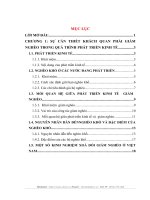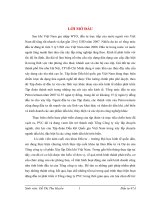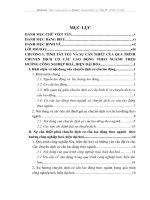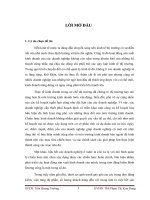SALINITY STRESS 2015
Bạn đang xem bản rút gọn của tài liệu. Xem và tải ngay bản đầy đủ của tài liệu tại đây (4.46 MB, 83 trang )
SALINITY STRESS
• Affects 7% of the total surface
• 5% of the cultivated land
• 20% Irrigated land is under secondary salanization
EXTENT OF SALT-AFFECTED SOILS
World’s Total area
12.78 b ha
FAO Database
397 x 106 ha (3.1%) – Saline soils
434 x 106 ha (3.4 %)– Sodic Soils
Asia, Pacific and
Australia (M ha)
195
249
Total : 444 M ha
Source : FAO database
“Salinity” represents all the problems of the soil accumulating excessive salts, which can be
categorized into sodic (or alkaline) and saline soils.
Sodic soils : poor soil structure generally spread over arid and semi-arid regions; retain high
concentrations of Na+ at the exchangeable site in the soil, which shows high pH (greater than 8.5)
with a high exchangeable sodium percentage (ESP > 15)
Saline soils : Generally found in arid regions and coastal fringes, which are dominated by Na + ions
with electrical conductivity (EC) more than 4 dS/m that corresponds to approximately 40 mM NaCl.
Moreover, saline soils exhibit ESP of < 15 and much lower pH values than the sodic soils
Adverse Effect of Salinity Stress
Plants have to cope with two major stresses under high salinity, osmotic
stress (Early occuring) and ionic stress (accumulating) .
Osmotic stress: Increases in cations and their salts, NaCl in particular, in
the soil generates external osmotic potential that can prevent or reduce the
influx of water into the root. The resulting water deficit is similar to drought
conditions and additionally compounded by the presence of Na + ions
Therefore, high salinity and drought stresses overlaps with each other
affect mostly all aspects of plant physiology and metabolism and cause
both hyper ionic and hyper osmotic stresses
The water potential gradient is reversed due to severe salinity/osmotic
stress (that is, an excessive amount of dissolved ions decreases
extracellular Ψosm ), water efflux from roots (dehydration) can occur.
To minimize the influence of a reduction in water influx, plants set
independent strategies in motion by regulating the root Lp (hydraulic
permeability Lpr) and attempting to restore ΔΨ by accumulating solutes
including organic compounds
However, time is required (> several hours or days) to accumulate enough
solutes inside the cell to get a decrease in intracellular Ψ osm (osmotic
adjustments).
Signal transduction and changes of related-gene expression, in contrast,
are a relatively quick response
Ionic streee : The stress phase develops later when toxic ions such as
Na+ accumulate in excess in plants exceed those of most macronutrients
Salinity causes ion-specific stresses resulting in an altered (decreased) K/Na
ratio. The external Na can negatively impact intracellular K influx. High
concentrations of Na+ ( extreme ratios of Na+/Ca2+ or Na+/K+)
Buildup of Na and Cl- concentrations in the cytosol, The Na can dissipate the
membrane potential and therefore facilitates the uptake of Cl down the
gradient.
Higher concentrations of sodium ions (above 100 mM) are toxic to cell
metabolism and can inhibit the activity of many essential enzymes, cell division
and expansion, membrane disorganization, and osmotic imbalance, which
finally can lead to growth inhibition.
Hydration shells of proteins are essential to maintain 3-D structure of proteins.
Na and Cl ions penetrate the shells of proteins. Interfere with non covalent
interactions between A. acids loss of function.
Increase in leaf mortality with chlorosis and necrosis, and a decrease in the
. Alterations in K ions can disturb the osmotic balance, the function of
stomata, and the function of some enzymes. Lead to a reduction in
photosynthesis and the production of reactive oxygen species
This salt-specific or ion-excess effect of salinity causes a toxic effect of
salt inside the plant. The salt can concentrate in the old leaves and the
leaves die, which is crucial for the survival and growth of a plant
High salinity affects cortical microtubule organization, helical growth in
Arabidopsis.
For most species, Na+ appears to reach a toxic concentration before Cl−
does, and so most studies have concentrated on Na+ exclusion and the
control of Na+ transport within the plant.
However for some species, such as soybean, citrus, and grapevine, Cl− is
considered to be the more toxic ion
Scheme of the two-phase growth response to salinity.
Manifestation of Salt Stress
Physiological & Biochemical
v High Na+ transport to shoot
v Preferential accumulation of Na in older leaves
v High Cl- uptake
v Lower K+ uptake
v Low P and Zn uptake
Manifestation of Salt Stress
Morphological Symptoms
v White leaf tip followed by tip burning (salinity)
v Leaf browning & death (sodicity)
v Stunted plant growth
v Low tillering
v Spikelet sterility
v Low harvest index
v Less florets per panicle
v Less 1000 grain weight
v Low grain yield
v Change in flowering duration
v Leaf rolling
v White leaf blotches
v Poor root growth
v Patchy growth in field
First symptom
“Leaf tip burning”
“Leaf tip burning
extends toward
base through
Lamina”
“Ultimate death
of leaf – always
from oldest to
youngest”
Salinity symptoms at the vegetative stage
R.K.Singh
Plant Breeding Course, April 06
Effect of salinity at Reproductive stage – Spikelet Sterility
Effect of salinity at reproductive stage – papery sterile spikelets
Many crop species are very sensitive to soil salinity and are known as
glycophytes, salt-tolerant plants are known as halophytes.
Exclude: Control of Na+ transport, Compartmentation
Salinity-tolerant plants have the capacity to sequester and
accumulate salt into the cell vacuoles, thus preventing the buildup of
salt in the cytosol and maintaining a high cytosolic K/Na ratio in
their cells
In general, glycophytes cannot grow at 100 mM NaCl, whereas
halophytes can grow at salinities over 250 mM NaCl
Salinity-sensitive plants
Strive to maintain an osmotic equilibrium by the synthesis of
compatible solutes such as prolines, glycine betaine (GB), sugars etc
In general, glycophytes cannot grow at 100 mM NaCl, whereas
halophytes can grow at salinities over 250 mM NaCl
MECHANISMS OF SALINITY TOLERANCE
• Cellular homeostasis which include ion homeostasis and OA
• Stress damage control – repair and detoxification
• Growth regulation
Cellular Ion homeostasis and OA
• Details of OA has been discussed in Drought tolerance
• Further the compatible solutes must be compartmentalised under both drought and
Salt tolerance for example Proline transportes (proT2 genes)
But the cellular Homeostasis is achieved by
• Extrusion/exclusion of Na+ out of the cell by plasma membrane either Na+/ H+
Antiporters or by limiting the Na+ entry
• utilization of Na+ for OA by Compartmentation by tonoplast Na+/ H+ Antiporters , i.e.,
tolerance of tissue to accumulated Na+, or in some species, to Cl−. Tolerance requires
compartmentalization of Na+ and Cl− at the cellular and intracellular level to avoid
toxic concentrations within the cytoplasm, especially in mesophyll cells in the leaf
• Na+ reabsorption
•
Hence regulation of Ion transport system is fundamental to salt stress tolerance
Sensory mechanisms of salt stress
Two sensory modalities are evident to NaCl : Ionic and purely osmotic stress.
To date, the molecular identities of plant hyperosmotic sensors and Na+ sensors have
remained elusive.
Histidine kinase receptor protein HK1 has been shown as osmosensor.
Plants exhibit many physiological responses to osmotic stress recent research has
shown that some of these responses are altered in hk1 mutants
Other proteins must still be perceiving the osmotic stress in addition to HK
Plant hyperosmotic sensors are closely coupled with Ca2+ channels
This Ca2+ response originates within the roots and occurs in several cell types support
of a mechano-osmotic sensory modality, mutations affecting cuticle development interfere with many osmotic-induced responses, including downstream abscisic acid (ABA)
production.
Thus, altering cuticle properties may affect the mechanical properties of water stress on
the cell
NA+ sensor ?
Scheme of the two-phase growth response to salinity.
Osmotic adjustments and compatible solutes
Certain organic compounds (compatible solutes) are known to
accumulate in the cytosol under salinity/osmotic stress conditions.
In addition to the role in osmotic adjustments, compatible solutes
seem to function as a chaperone protecting enzymes and membrane
structures, and as a scavenger reducing radical oxygen species under
stress conditions including salinity stress.
Ion accumulations in the cytosol (mainly K+) and in the vacuole (Na+,
especially in salt tolerant cultivars/species) are also found to be
important for the osmotic adjustment of plant cells









